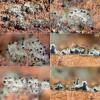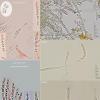
29-12-2015 00:41
Hi to everybody I need your help with this fungus

28-12-2015 05:24
Collected 24 december 2015, on Ulmus americanus ba

28-12-2015 10:39
 Joop van der Lee
Joop van der Lee
Found on cow dung.Apothecia: 2.67 mm in diameter;

27-12-2015 14:04
 Bernard CLESSE
Bernard CLESSE
Bonjour à tous,Voici un Hypocrea venant sur branc

26-12-2015 13:08
Nina FilippovaDear colleagues,I would appreciate your help in fi

27-12-2015 16:40
Cvenkel MiranphotoIn beetween oak log & ground. From far it

25-12-2015 20:55
Gernot FriebesHi,in September I found this earth tongue in Liech

24-12-2015 23:34
 Alan Rockefeller
Alan Rockefeller
Found on conifer wood in Atemajac de Brizuela, Ja
I need your help with this fungus that forms superficial black, lageniform, ostiolate perithecia, up to 0.45 mm high, 0.2 mm broad with necks 0.1 mm in diameter, singly or clustered in groups of several perithecia covered by a copious whitish or greenish blue, aerugineous subiculum. Non stromatic or very inconspicually stromatic.
The irregulary disposed clusters covering several cm on rotten wood of Alnus glutinosa at the Botanical garden of Gijón, at the north of Spain at the sea level.
The narrowly clavate asci, 8-spored but four of them aborted, 44-58 x 4-5 microns, have an strongly refringent apical apparatus not really Melzer positive. The ascospores are hyaline, smooth, biguttulate, one-celled, 4.9-5.8 x 2.6-3.1.
I don not have any good track, but perhaps you could help me?
Thanks in advance

nice find! I would suggest to dig into Boliniales but I have no genus to propose.
Amplistroma might be considered too but it has consistently globose ascospores.
Can you check the presence of a germ pore on ascospores? They are minute and hyaline, it might be challenging.
Good luck,
Jacques
Hi Jacques
With the kind permission of Jesús Linde, allways the collector, I could send you a part of this collection together with A. michelianum. Do you like it?
Thanks a lot, as allways!
PD. I couldn't see any germ pore at the ascospores


